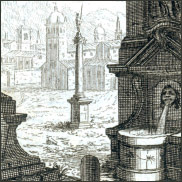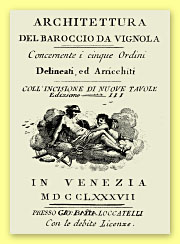|

|
Freemasons are taught to make the Liberal Arts and Sciences their study.
Although Freemasonry’s association with the stonemason’s and architect’s craft is perhaps more symbolic than historical, it’s study is none the less a part of a masonic education. Unlike Christopher Wren, Freemasonry can make no claim on Giacomo da Vignola, or Villard de Honnecourt.
| |
|
|
|
|
|
|
The five noble orders of architecture
|
 Giacomo da Vignola (b. 01/10/1507, d. 07/07/1573), a theoretical and practical architect of the Transition Period between the Renaissance and Baroque styles, was the pupil and successor of Michelangelo. Born Giacomo Barozzi, in 1550 he was made papal architect by Pope Julius III. His The Five Orders of Architecture (1563; trans. 1889), became a standard work on the subject and was translated into many languages. Based upon the work of Marcus Vitruvius Pollio (fl. 1st century CE), it undertook to formulate definite and minute rules for proportioning the
classical orders appearing in the buildings of the Romans. This work, which has been in continuous use, has been scrupulously adhered to by many as an almost inviolable authority.
Giacomo da Vignola (b. 01/10/1507, d. 07/07/1573), a theoretical and practical architect of the Transition Period between the Renaissance and Baroque styles, was the pupil and successor of Michelangelo. Born Giacomo Barozzi, in 1550 he was made papal architect by Pope Julius III. His The Five Orders of Architecture (1563; trans. 1889), became a standard work on the subject and was translated into many languages. Based upon the work of Marcus Vitruvius Pollio (fl. 1st century CE), it undertook to formulate definite and minute rules for proportioning the
classical orders appearing in the buildings of the Romans. This work, which has been in continuous use, has been scrupulously adhered to by many as an almost inviolable authority.
|
 The Golden Mean. [download 600ppi gif file]
The Golden Mean. [download 600ppi gif file]
|
|
Illustrations reproduced from Regola delli cinque ordini d'architettura Architettura del Baroccio da Vignola : concernente i cinque Ordini : la "Regola" del Vignola in una edizione del XVIII secolo / presentazione di Alberto Pratelli. Bologna : CLUEB, [1984] xli, 72 p. : ill. ; 22 cm. LCCN: 86225988.
Sidebar illustration reproduced from: BAROZZI Giacomo da Vignola, Regola delli cinque ordini d'architettura. In Milano, Giuseppe Galeazzi, s.d. [fine '700]. Venduto In 16¡, pp. 74, con 36 tvv. n.t. a piena pagina, front. inciso, leg. coeva in carta marmorizzata con etichetta manoscritta al piatto ant.; antica firma di possesso al front.
|
|